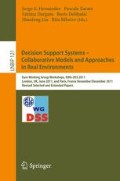Abstract
Clinical decision making faces relevant uncertainties, outcomes and trade-offs. It has to deal with diagnosis uncertainties, the choice of diagnostic tests, the selection of prescriptions and procedures, and the treatment follow up, many times facing severe budget limitations and lack of sophisticated equipment. This paper presents a multi-agent learning system for health care practitioners: SimDeCS (Simulation for Decision Making in the Health Care Service). This system relies on simulations of complex clinical cases integrated in a virtual learning environment, and has been developed within a program offering continuous education, training and qualification to professionals in the Brazilian health care service. SimDeCS will be made available on the Internet, thus providing access to professionals working throughout the country. The main contribution is the system architecture and the model knowledge.The learning environment has been designed as a multi-agent system where three intelligent agents are included: Domain Agent, Learner Agent, and Mediator Agent. The knowledge model is implemented by the Domain Agent through probabilistic reasoning, relying on expert human knowledge encoded in Bayesian networks. A clinical case is presented and discussed.
Access this chapter
Tax calculation will be finalised at checkout
Purchases are for personal use only
Preview
Unable to display preview. Download preview PDF.
References
Flores, C.D., Seixas, L.J., Gluz, J.C., Vicari, R.M.: A Model of Pedagogical Negotiation. In: Bento, C., Cardoso, A., Dias, G. (eds.) EPIA 2005. LNCS (LNAI), vol. 3808, pp. 488–499. Springer, Heidelberg (2005)
Luiz, M., Helder, C.: On tailoring teams of software agents tuned for tasks. In: Proceedings of the Workshop on Multi-Agent Systems: Theory and Applications (MASTA 2001). 10th Portuguese Conference on Artificial Intelligence. Porto, Portugal (2001)
Holzinger, A., Kickmeier-Rust, M.D., Wassertheurer, S., Hessinger, M.: Learning performance with interactive simulations in medical education: Lessons learned from results of learning complex physiological models with the HAEMOdynamics SIMulator. Computer and Education 52, 292–301 (2009)
Botezatu, M., Hult, H., Fors, U.G.: Virtual patient simulation: what do students make of it? A focus group study. BMC Medical Education 10, 91 (2010)
Bradley, P.: The history of simulation in medical education and possible future directions. Medical Education 40, 254–262 (2006)
Kneebone, R.: Simulation in surgical training: educational issues and practical implications. Medical Education 37(3), 267–277 (2003)
Jensen, F.V., Olsen, K.G., Andersen, S.K.: An algebra of Bayesian belief universes for knowledge-based systems. Networks 20, 637–659 (1990)
Suebnukarn, S., Haddawy, P.: A Bayesian approach to generating tutorial hints in a collaborative medical problem-based learning system. Artif. Intell. Med. 38(1), 5–24 (2005)
Suebnukarn, S.: Intelligent tutoring system for clinical reasoning skill acquisition in dental students. J. Dent. Educ. 73(10), 1178–1186 (2009)
Athanasiou, M., Clark, J.Y.: A Bayesian network model for the diagnosis of the caring procedure for wheelchair users with spinal injury. Comput. Methods Programs Biomed. 95(suppl. 2), S.44–S.54 (2009)
de Oliveira, L.S., Andreão, R.V., Sarcinelli-Filho, M.: The use of Bayesian networks for heart beat classification. Adv. Exp. Med. Biol. 657, 217–231 (2010)
Pearl, J.: Belief networks revisited. Artificial Intelligence 59, 49–56 (1993)
Chakravarthy, B.: Medical Simulation in EM Training and Beyond. Newslett. Soc. Acad. Resid. 18(1), 18–19 (2006)
Ziv, A., Ben-David, S., Ziv, M.: Simulation Based Medical Education: an opportunity to learn from errors. Medical Teacher 27(3), 193–199 (2005)
Kincaid, J.P., Hamilton, R., et al.: Simulation in Education and Training. In: Modeling and Simulation: Theory and Applications, ch. 19. Kluver, Boston (2004)
Scalese, R.J., Obeso, V.T., Issenberg, S.B.: Simulation Technology for Skills Training and Competency Assessment in Medical Education. J. Gen. Intern. Med. 23(suppl. 1), 46–49 (2008)
Issenberg, S.B., McGaghie, W.C., Petrusa, E.R., Gordon, D.L., Scalese, R.J.: Features and uses of high-fidelity medical simulations that lead to effective learning: a BEME systematic review. Med. Teach. 27, 10–28 (2005)
Nishisaki, A., Keren, R., Nadkarni, V.: Does Simulation Improve Patient Safety?: Self-Efficacy, Competence, Operational Performance, and Patient Safety. Anesthesiology Clinics 25, 225–236 (2007)
Bleakley, A., Bligh, J., Browne, J.: Beyond Practical Reasoning. In: Medical Education for the Future: Identity, Power and Location, ch. 2. Springer, New York (2011)
Jensen, F.V.: An Introduction to Bayesian Networks, 188 p. UCL Press, London (1996)
Mossmann, J.B.: VR-MED: Domain-Specific Language for the Development of Virtual Environments Applied to Family Medicine. Technical report, Pontifícia Universidade Católica do Rio Grande do Sul (2011)
FIPA. SC00001L: Abstract Architecture Specification [S.l.] (2003), http://www.fipa.org/specs/fipa00001/ (accessed in October 1, 2011)
Jade - Java Agent Development Framework, http://jade.tilab.com/
Brazilian Society of Family Medicine and Community (Sociedade Brasileira de Medicina de Família e Comunidade), http://www.sbmfc.org.br/
Author information
Authors and Affiliations
Editor information
Editors and Affiliations
Rights and permissions
Copyright information
© 2012 Springer-Verlag Berlin Heidelberg
About this paper
Cite this paper
Flores, C.D., Bez, M.R., Respício, A., Fonseca, J.M. (2012). Training Clinical Decision-Making through Simulation. In: Hernández, J.E., Zarate, P., Dargam, F., Delibašić, B., Liu, S., Ribeiro, R. (eds) Decision Support Systems – Collaborative Models and Approaches in Real Environments. EWG-DSS 2011. Lecture Notes in Business Information Processing, vol 121. Springer, Berlin, Heidelberg. https://doi.org/10.1007/978-3-642-32191-7_5
Download citation
DOI: https://doi.org/10.1007/978-3-642-32191-7_5
Publisher Name: Springer, Berlin, Heidelberg
Print ISBN: 978-3-642-32190-0
Online ISBN: 978-3-642-32191-7
eBook Packages: Computer ScienceComputer Science (R0)

